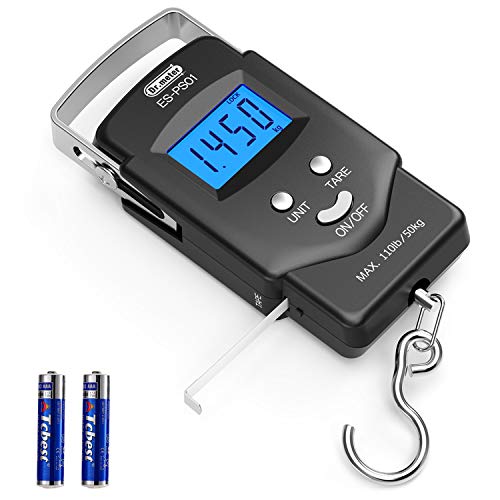In early June, when the weather finally cleared up after an exceptionally wet May, we headed out to the Dry River. I wanted to fish the lower stretch a little bit closer to Rawley Springs than the other sections I had hit on earlier trips. The Dry River is a year-round brook trout fishery due to the cold water that flows out of the base of Skidmore Dam. The fishable section of the Dry River starts at Riven Rock Park, a 28-acre park bordering the George Washington National Forest. We drove upstream from the park until we started to see the 4×4 trails created by the off-road folks.
This area experiences heavy, active use by many off-road vehicle clubs in Virginia. As you drive up Route 33 towards West Virginia, expect to see an almost infinite number of cutoffs on either side of the highway. Most of the cutoffs to the left will lead to the river. It goes without saying that when you’re fishing you may see a convoy of jeeps or other off-road vehicles trundling through the riverbed as they enjoy this aspect of the recreational opportunities here. We pulled off at one of those random trails and drove until we were cut off by a deep gully that separated us from the river. A short walk put us on the water, and we began to fish upstream.
The Dry River is one of my favorite places in Virginia, within a reasonable driving range of Northern Virginia. I believe that there are almost 14 fishable miles of the Dry River that support public access, so you can spend days here without ever going back to the same place. In fact, that’s why you see so many posts on this website related to the Dry River. I’ve never been on the same stretch of water twice. The Dry River is typically 20 to 30 feet wide and shallow. If you like riffles, you have 14 miles of them here. In general, the river stays about 1 foot deep, and you find the pools where the water stacks up above where the gradient pitches the river down a foot or two. Obviously, there are pools at the bends in the river where the water has dug out the bottom. The Dry is a river you must get into and start fishing as you do not know where those good spots will be. If the weather is dry, the river will have enough flow to widen and create spots to create the broad areas, as you see in the picture below.
Given that the water is so shallow in most places, I have found that it’s better to stick with a top water presentation rather than try and use streamers or nymphs. The nymphs collect crud from the bottom of the riverbed and the streamers continually get hung up as they encounter the small branches or other debris that litters the bottom. The good news is that the brookies here eagerly anticipate the arrival of your dry fly. As long as you lay it down gently and manage drift, you will get a hit. It’s also interesting to note that the fish seem to have become accustomed to the high amount of traffic in the river from fishermen, off-road vehicles and picnickers. While they are cautious, they do not appear to be overly spooky. In addition to the brookies who live here year-round, the Dry River is a prime stocking location and gets its fair share of rainbow trout dumped into it every year. During the stocking season, expect to see more crowds but once those fish have been cleaned out, it’s back to brookies which are too small to be interesting for most bait and spin fishermen.
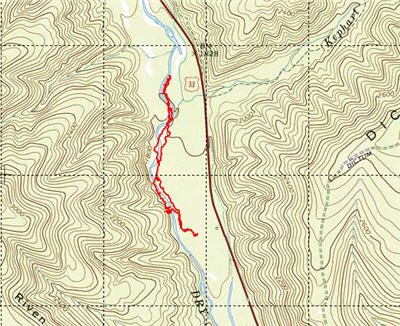
It’s pretty easy to wade, but you may want to bring a wading staff with you to help negotiate the rocky banks in some sections. The clank of the wading staff on the bottom of the river is also a warning to the brookies that you are approaching, and they will scatter.
On this particular trip, the dry fly patterns that I found most effective included size 16 Adams and Mr. Rapidan. We did not see a hatch while we were here but, given the rocky bottom which creates optimum habitat, this is something you should anticipate.
Dry River Trout Fishing Bottom line: If you want to experience a good day of brook trout fishing without having to bushwhack into the Shenandoah National Park, the Dry River is the answer to your prayers. It sports easy access from the road; although you do need a four-wheel drive vehicle to penetrate without having to walk. Even without the four-wheel drive vehicle, the river is generally within 50 yards of the road and there are other sections of the Dry River that I cover in other posts that feature parking close by. As I said above, I believe the Dry River is one of the better places to fish close to Northern Virginia and I certainly will return here at least once or twice every season.
Getting There: Take exit 247B from I81 at Harrisonburg and get onto Rt 33 west. Follow Rt 33 for about 15 miles to Rawley Springs. Start fishing anywhere after Riven Rock Park.
Google Local Coordinates: 38.527085,-79.059849
Secrets Revealed? No. This is a very public location that is documented in the following places:
Virginia VDGIF
Flyfisher’s Guide to Virginia
Mid-Atlantic Budget Angler
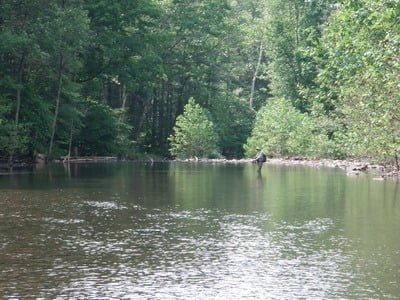
Jim working a broad pool near the lower part of the red line
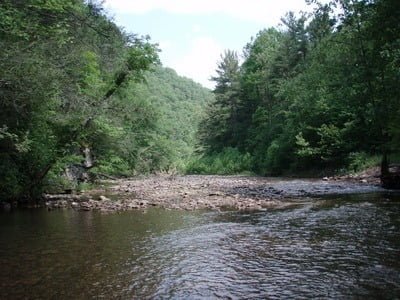
The Dry moves left and right in its bed to create riffled areas
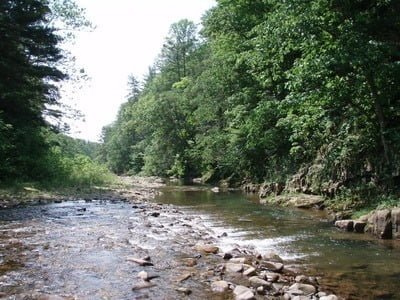
“Deep” pools cluster near bends or breaks
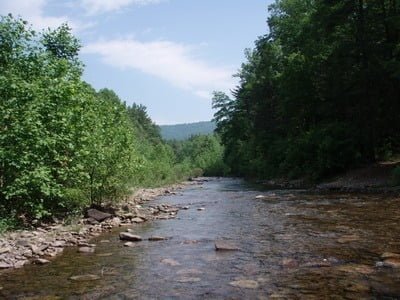
Broad, shallow… but the brookies are here
Unless stated otherwise, this article was authored by Steve Moore

